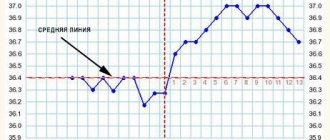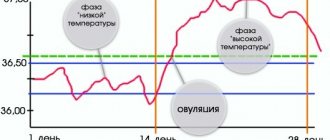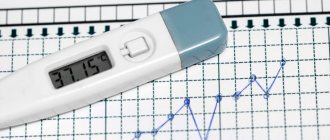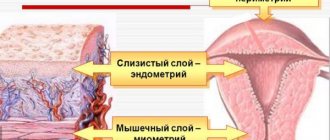A woman must constantly monitor her health in order to recognize the problem in time and begin treatment. The method of plotting basal temperature charts will help a woman, without resorting to expensive examinations at the initial stage, to determine whether everything is in order with her women’s health, and for what reason the long-awaited pregnancy does not occur.
Basal temperature is the temperature of a person’s body when waking up in the morning. In women, it varies depending on the phase of the menstrual cycle, hormone levels and general well-being.
Measuring basal temperature is one of the main methods for assessing the functioning of the ovaries and menstrual function of the female body. For example, by measuring basal temperature, you can see if there are problems in the functioning of the endocrine system, suggest the presence of inflammatory gynecological diseases, and detect the onset of pregnancy at the earliest stages.
For greater accuracy, basal temperature is measured by inserting a thermometer into the vagina or rectum. To get a clear picture of the course of the menstrual cycle, you need to measure your basal temperature and draw up a schedule every day for three to four months.
Normal basal temperature chart
Rectal temperature analysis is very often performed when planning pregnancy . Temperature can respond to hormonal surges. This interaction makes it possible to detect deviations in the functioning reproductive system .
Experts have put forward standard parameters, compliance with which indicates that the woman is healthy. Any deviation indicates the development or progression of diseases of the genital area .
ON A NOTE! An ideal schedule does not have to be a 28-day cycle. Any other duration is acceptable.
A normal basal temperature chart for a healthy woman has a number of characteristic features . These include the following:
- At the beginning of the menstrual cycle (days of menstruation are not taken into account), BT is approximately at the same level , in the range from 36.2 to 36.5 degrees.
- According to observations of the first six days after menstruation, the indicators should have the same marks, a deviation of 0.1–0.2 °C is allowed. A line is drawn based on the average value of these days . In the chart above, the indicator is at 36.4. If on some day there was an abnormal jump and there is an explanation for this (for example, sexual intercourse, poor quality of sleep, stress, etc.), then such a deviation should not be taken into account.
- A few days before the release of the egg, a “ preovulatory retraction ” occurs by 0.1–0.4 degrees from the average value. In the graph above, this is day 12 of the cycle.
- Immediately after the follicle ruptures, BT increases by 0.4–0.6 °C. On the graph, before this increase, an ovulation line is drawn - it separates the follicular and luteal phases.
- After ovulation, the temperature will be constantly elevated or will increase slowly.
- If pregnancy does not occur, then “ premenstrual retraction ” occurs. Indicators 3–5 days before the start of menstruation drop by 0.1–0.3 degrees. On the chart this is day 26.
Normally, the difference in average temperatures between the first and second phases should be at least 0.4 degrees. If the value is lower, this may indicate hormonal imbalances.
During the follicular stage, temperature depends on estrogen levels. It affects the growth of follicles and endometrium. In the luteal phase, levels increase due to an increase in progesterone. It is produced by the corpus luteum, which occurs at the site of follicle rupture.
After conception
The basal temperature in the second (luteal) phase remains at 37-37.3 °C. However, determining pregnancy by it is possible only if ovulation occurs in the cycle. If there are certain disorders in the body, the temperature may be exceeded, and menstruation will be absent.
Throughout pregnancy, the temperature will remain elevated. Its decrease may indicate an ectopic pregnancy or a threatened miscarriage.
Basal temperature allows you not only to find out the date of release of the egg from the follicle, but also to suspect something is wrong in your health. Therefore, measuring it is not a waste of time. However, it is not worth judging the health of the reproductive system based only on basal temperature indicators. Every extra degree missing is not a reason to panic. Only a doctor can make a final diagnosis after additional examinations.
Views:
6680.
BT value for deviations
The BT schedule is of significant benefit in diagnosing certain diseases. But it is important to remember that only long-term studies . You can't draw conclusions based on one month. An abnormal graph structure may indicate the presence of the following deviations:
- Estrogen-progesterone deficiency.
- Anovulation.
- Insufficiency of the corpus luteum.
- Estrogen deficiency.
- Inflammatory diseases.
- Endometritis.
The data indicated in the graph is confirmed in conjunction with the characteristic signs of diseases. The duration of the menstrual cycle, the presence of specific discharge, pain and the emotional state of the woman are taken into account.
Change in cervical mucus
Your cervical mucus will also change at different stages of your cycle. Right away this will be blood from days 1 to 7 depending on how long your period lasts. Then it will gradually begin to change. It will change daily during the two weeks of your cycle. Here are the different types of cervical mucus, by approximate time period:
| Cycle days | Characteristics of cervical mucus (natural secretions in the cervix) |
| 1-7 | Red/blood on period (denoted as "M" on your chart) |
| 8-9 | Dryness or lack of mucus (about in the chart) |
| 10-11 | Sticky (“L”) |
| 12 | Creamy, may look like watery body lotion (“B” in graphic) |
| 13-14 | Like egg white, transparent, very thin and stretches between your fingers. This is a very fertile mucus that helps the sperm reach the egg and is released only during ovulation (“O”) |
After the 15th day until your next period, the mucus will return to a dry, sticky, and creamy appearance.
You can conceive from the day mucus in the form of egg whites (indicated by “O”) begins to be produced until it disappears. The favorable period can last from 3 to 5 days during ovulation, since sperm can remain alive during this time.
This method should be used in conjunction with a basal temperature chart to more accurately predict the timing of ovulation and possible pregnancy. Here's an example diagram:
Figure 3: Cervical mucus and basal temperature in the absence of pregnancy (example)
For estrogen deficiency
Estrogen combines several types of hormones that influence the processes of the follicular phase. These include estrone, estradiol and estriol. Estrogen production occurs in the ovaries. As a result of this, the follicles increase in size. Around days 10–12 of the menstrual cycle, a dominant follicle . The ovulation process is characterized by its rupture on days 14–15 with a cycle of 28 days.
Normally, BT levels in the follicular stage should be reduced due to high estrogen levels and range from 36.2-36.5 °C. With low estrogen levels, the temperature remains above normal values. Due to the chaotic nature of the data, it is difficult to detect ovulation.
In the second phase, the rise in temperature is slowed down. Problems with estrogen lead to disturbances in other hormones, which is a consequence of elevated temperature in the luteal phase. Getting pregnant with such a schedule is extremely problematic - treatment is required.
REFERENCE! If there is a lack of estrogen, periods may come with the same frequency. The absence of obvious symptoms of the disease prevents a woman from detecting it.
A similar graph can be observed during the inflammatory process, when estrogens are normal.
Significance of indicators
A woman’s menstrual cycle is influenced by the ratio of certain sex hormones: estrogens, progesterone, prolactin, hCG, etc. The regularity of menstruation and a woman’s ability to conceive a child depend on their balance. Normally, the duration of the period between menstruation is from 28 to 36 days. Because of this, it is impossible to say with certainty on what day a girl will ovulate. Every woman of reproductive age is recommended to keep her own calendar in order to increase the chance of conceiving a child or avoid unwanted pregnancy.
Find out whether conception is possible during menstruation in the article at the link.
Basal temperature provides information about the functioning of internal organs. It is determined in the morning, after waking up. Any physical activity before taking measurements will negatively affect the information content of the result obtained.
The indicator is measured only in those cavities that are connected to the internal parts and systems: mouth, vagina and anus.
For inflammation of the ovaries
The schedule for the inflammatory process looks quite specific. It is characterized by intense temperature jumps. They can be noticed in the first half of the menstrual cycle. The indicators reach 37 degrees and remain at this level for several days.
Then there is a sharp decrease in temperature . A woman may confuse this phenomenon with early ovulation. To prevent this from happening, it is recommended to analyze the graph in conjunction with an ultrasound examination.
IMPORTANT! In the presence of an inflammatory process, a change in vaginal secretion and the appearance of painful sensations in the lower abdomen and back are noted.
For estrogen-progesterone deficiency
If there is a simultaneous lack of two important hormones : estrogen and progesterone, there is a slight increase in temperature in the second phase (by 0.1–0.3 °C), and the release of the egg has a slight increase in indicators.
If you have such a schedule, you should visit a gynecologist. After the examination, the specialist will prescribe appropriate treatment aimed at restoring hormonal levels .
In case of corpus luteum deficiency
After ovulation has occurred, the luteal stage begins to operate; it is also called the corpus luteum phase , which is formed at the site of the burst follicle and produces progesterone, the pregnancy hormone. Its main function is to prepare the endometrium for implantation of a fertilized egg, and it is also responsible for supporting the luteal phase. Its deficiency affects reproductive function.
On the graph, corpus luteum deficiency is expressed by a slight increase in temperature in the period after ovulation, and before menstruation there is no decrease in values. And also confirmation of the insufficiency of the luteal phase is the short duration .
Normally, it should be from 12 to 16 days, ideally 14 days. If the duration exceeds 16 days, then this may indicate pregnancy, an inflammatory process, as well as the formation of a corpus luteum cyst.
REFERENCE! If progesterone is low, experts prescribe hormonal medications such as Utrozhestan or Duphaston. The classic regimen is from days 16 to 25 of the cycle.
Treatment
There are many reasons for anovulation. Therefore, there cannot be universal recipes and treatment regimens. Everything will depend on the test results of a particular patient. It is important for the doctor to determine the cause of this condition and eliminate it.
- Sometimes it is enough to adjust your diet and lifestyle, avoid lack of sleep and overwork. For example, take a vacation;
- If obesity is to blame, you will have to lose weight;
- If you are underweight, you need to gain it (fat mass should be at least 18% of body weight);
- If the problem is a pathology of the thyroid gland, hormones are prescribed that will improve its function. Often this is enough for ovulation to begin;
- Problems with the pituitary gland are solved by taking hormonal drugs or drugs that increase blood circulation to the brain;
- If the problem is an inflammatory disease, you need to cure it or achieve stable remission;
- For polycystic disease, hormonal drugs are most often prescribed;
- Sometimes prescribing oral contraceptives in a short course (for 2-3 months) helps. COCs will “start” the ovaries, and after discontinuation, spontaneous ovulation is possible;
- In some cases, stimulation with special drugs is required. For example, clostilbegit is prescribed to stimulate ovulation;
- Phytotherapy, physiotherapy, and vitamin therapy are used as auxiliary methods.
Anovulation is successfully treated in 90% of cases. It is important to find a good doctor, follow his recommendations and believe that soon you will come to see him with a beautiful round tummy.
In practical gynecology, five types of basal temperature measurement charts are used. One of these typical charts is the anovular method of measuring basal temperature.
Basal temperature - chart
In the absence of ovulation
Anovulation is characterized by a quiet schedule. In this case, the temperature throughout the cycle is approximately at the same level . The follicle does not rupture, so in the middle of the cycle a significant increase in temperature is not recorded. The corpus luteum is not formed , and accordingly, the level of progesterone does not increase, so the temperature does not rise in the luteal phase.
An anovulatory schedule is acceptable 1-2 times a year, even in completely healthy women. In other cases, we are talking about a hormonal disorder. You should immediately visit a doctor to begin timely treatment.
For endometritis
By analyzing basal temperature, you can identify the presence of a disease such as endometritis. Normally, at the beginning of a new cycle, the temperature should decrease . If during menstrual flow an increase in BT occurs and remains at this level, then this is a clear symptom of the presence of the disease.
Along with this, the appearance of other symptoms of the disease is noted. These include the following:
- Painful sensations during sexual intercourse.
- Feeling worse.
- Cycle disruption.
- Purulent discharge.
- Uterine bleeding.
It is not recommended to determine deviations from the BT schedule yourself. This should be done by the attending physician . Treatment is prescribed based on the results of tests and other studies.
What is an anovulatory cycle?
As the name suggests, an anovulatory cycle is a period when a woman misses ovulation. For those who do not plan to have children, use contraception, or do not attach any importance to it, anovulation often occurs unnoticed. This is due to the peculiarity of menstrual bleeding - periods can occur as usual.
In a normal menstrual cycle, the production of the hormone progesterone, which regulates bleeding during menstrual periods, is stimulated by the release of the egg. It is this hormone that helps a woman’s body maintain regular periods. During the anovulatory cycle, insufficient levels of progesterone can cause uterine bleeding of a different nature, which is mistaken for menstruation.











